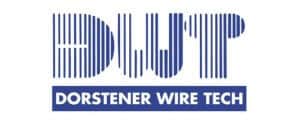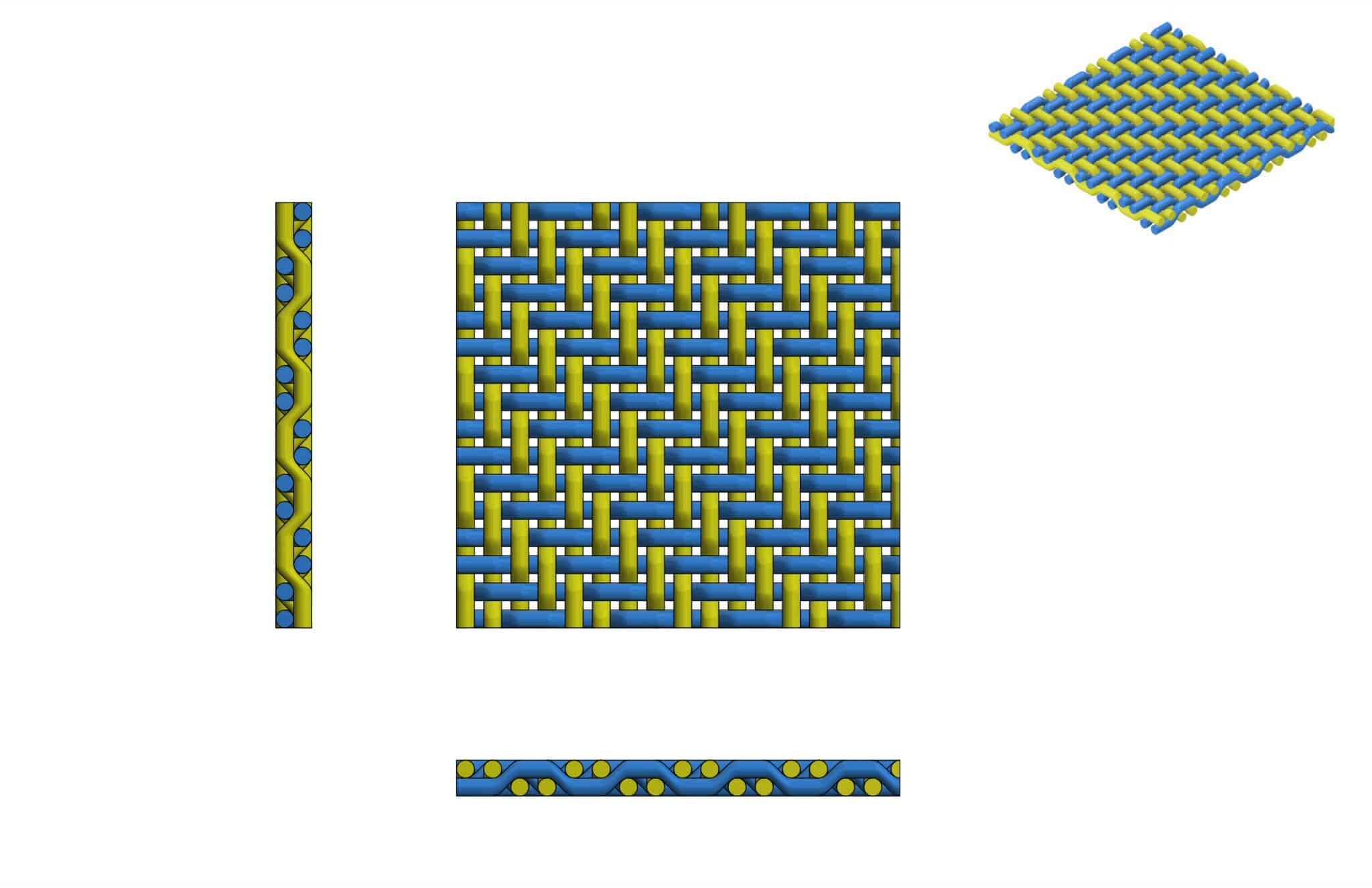Wire Cloth Terminology
When choosing your preferred wire mesh or wire cloth, please refer to Dorstener Wire Tech’s wire cloth terminology page for your reference. Contact us for more information or assistance.
- Absolute filtration rating – The diameter of the largest hard spherical particle that will pass through a filter under specified test conditions. This is an indication of the largest opening in the filter cloth.
- Air flow/air permeability – Measure of the amount of air that flows through a filter–a variable of the degree of contamination, differential pressure, total porosity, and filter area. Expressed in either cubic feet/minute/square foot or liters/minute/square centimeter at a given pressure.
- Aperture – See Mesh Opening.
- Binding (plugged) A filter element that has collected a sufficient quantity of insoluble contaminants such that it can no longer pass rated flow without excessive differential pressure.
- Bolting Grade – Used in sifting and sizing applications and general filtration applications. Higher percent of open area compared to market and mill grade. Usually woven in a square weave.
- Bubble point test – A test to determine the maximum pore size opening of a filter.
- Calendering – A process by which fabric or wire is passed through a pair of heavy rollers to reduce thickness, to flatten the intersections of the threads/wires and to control air permeability. Rollers are heated when calendaring synthetic materials.
- Clear Openings – Space between adjacent parallel wires. (also Space)
- Crimp – Corrugations in wire to permit locking them in place when perpendicular to each other.
- Differential pressure – The difference in pressure between two points of a system, such as between two sides of an orifice.
- Downstream – The side of a product stream that has already passed through a given filter system; portion located after the filtration unit.
- Dutch Weave – Warp and weft wire diameters are different in size and the weft wires are closer together to provide excellent strength and high density.
- Effective area – The total area of the porous medium exposed to flow in a filter element.
- Efficiency – The ability, expressed as a percent, of a filter to remove specified artificial contaminant at a given contaminant concentration under specified test conditions.
- Feed side – The side of a filter or filtration processing system is where the material to be filtered enters.
- Filter Cloth – Woven mesh cloth used for filtration and straining. It is a tightly woven cloth usually of Dutch Weave.The filter cloth is used for centrifugal and vacuum filter applications. It lies flat and is free from waviness.
- Filter life – Measure of the duration of a filter’s useful service. This is based on the amount of standard contaminant required to cause differential pressure to increase to an unacceptable level-typically 2-4 times the initial differential pressure, a 50-80% drop in initial flow, or an unacceptable downstream measure of particulate.
- Filter media – A porous material for separating suspended particulate matter from fluid.
- Filtration – A process of separating particulate matter from a fluid by passing it through a permeable material.
- Flow rate – Measure of the amount of fluid passing through the filter. This is always a variable of filter area, porosity, contamination and differential pressure.
- Inter-Crimp Wire Cloth – Woven wire cloth with an extra crimp in both warp and fill wire. Both the warp and shute wires are crimped with extra crimps or corrugations between the points of intersection. This technique is usually required when weaving large openings with fine wires.
- Market Grade – Most commonly used sizes of industrial wire cloth specifications selected for general purpose work.
- Micronic Filter Cloth – Very durable and strong cloth. Also referred to as “Dutch Weave”. Usually supplied in a twilled Dutch or plain Dutch weave depending on the mesh count. Normally used in filtration applications such as pressure filters, fuel filters, and many more.
Mill Grade Used mostly in sifting and sizing applications. Higher percent of open area compared to market grade. Usually woven in a square weave. - Mean filtration rating – Derived from Bubble Point test method. Data should be used as a guide only to compare overall retention capabilities between fabrics and should not be considered a guarantee of the particle size that the fabric will retain.
- Mesh – Number of openings in a linear inch measured from the center of one wire to a point 1″ distant.
- Mesh count – The number of threads in a linear centimeter or inch of fabric/wire cloth.
- Mesh opening – The difference between wires measured in the warp and weft direction in the projected plane of the wire mesh.
- Mesh size – Mesh size is the mesh number (a US measurement standard) and its relationship to the size of the openings in the mesh and thus the size of particles that can pass through these openings. Figuring out the mesh number is simple. All you do is count the number of openings in one linear inch of screen. This count is the mesh number. A 4 mesh screen means there are four little square openings across one inch of screen. A 100 mesh screen has 100 openings per inch, and so on.
- Micron – Micron is the measure of length most frequently used to describe tiny particle size. The term micron is actually a commonly used shorthand for micrometer (American spelling) or micrometre (international spelling). The official symbol for the micron or micrometer is μm, sometimes simplified as um. A micron is defined as one-millionth of a meter, a little more than one twenty-five thousandth of an inch, the size of coal dust or baking flour. The smallest bacteria are about ½ micron.
- Open area – The proportion of total screen area that is open space. Expressed as a percentage.
- Pore size – Filters are rated according to the size of particles they can remove. Particles which are bigger than indicated pore size, are removed. Smaller particles pass through the fabric. The size of particles is measured in micro-meters or “microns” one micron being equal to one-millionth of a meter or one-thousandth of a millimeter, the size of coal dust or baking flour. The smallest bacteria are about ½ micron.
- Pre-crimp Mesh – The wire is crimped prior to weaving. Mostly limited to coarse mesh with larger wire diameters.
- Selvage Edges – A loom finished edge that prevents cloth unraveling.
- Separation – This process divides or separates a mixture of particles or liquids into separate components.
- Shute Wires or Weft – Fibers or wires running across the width of the cloth as woven.
- Square weave – See Plain Weave.
- Space Cloth – This mesh has a clear opening size. 1″ X 1″ Space Cloth has a 1″ clear opening. 1 X 1 mesh has lass than a 1″ opening.
Strainer Grade Wire cloth with a rectangular opening. Also referred to as an oblong mesh and off-count mesh. Used in filtration and straining applications. - Twill weave – Formed by passing the warp or weft fiber over two or more fibers in the opposite direction.
- Warp Wires – Wire running the length of the cloth as woven.
- Weft or Shute Wires – Fibers or wires running across the width of the cloth as woven.
- Wire diameter – See Thread diameter.
Wire Cloth Terminology Courtesy Dorstener Wire Tech
Wire Cloth Terminology Disclaimer – The information provided by this wire cloth terminology page is for informational purposes only. The purpose of this page is to promote understanding of wire cloth terminology only. Dorstener Wire Tech is not responsible for it’s accuracy or consequences from the use of this information.
Wire Cloth Terminology – Common Wire Cloth Types
HAVE QUESTIONS OR NEED A QUOTE?
If you have any questions, need a quote or would like to receive more detailed information on our products and services, please contact us today. We are ready to serve you.
DORSTENER WIRE TECH
Physical Address
19994 Hickory Twig Way
Spring, TX 77388 USA
Mailing Address
P.O. Box 3019
Spring, TX 77383
PHONE
(888) 931-9473 toll free
(281) 651-6226 local
(281) 651-6228 fax






